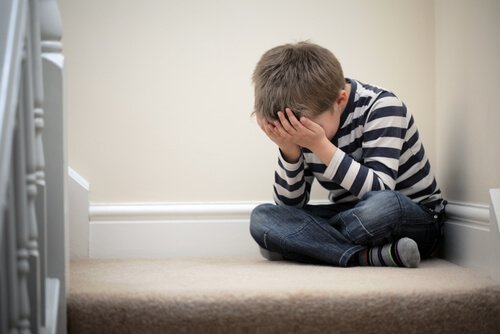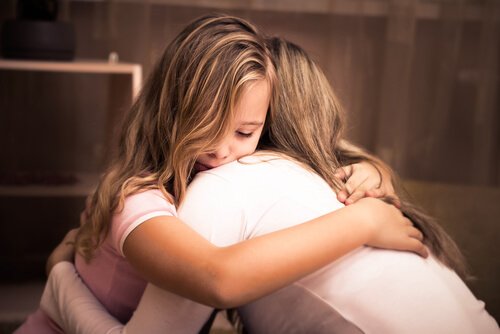Panic Disorder in Children

In today’s article, we’ll discuss just what you need to know about panic disorder in children and what you can do about it.
What is panic disorder?
Panic disorder is an intense unease that affects a person both emotionally and physically. The cause of this disorder can be both a real or fictitious threat.
Above all else, it usually produces the sensation that one has lost control over him or herself. This causes significant behavioral changes in children.
A panic attack can last just a short time, but the physical consequences can last longer in a child’s body. These may include symptoms such as trembling, a seemingly insignificant headache, and others.
At the same time, once a panic attack is over, children still experience fear. They continue to feel strong anxiety just at the thought of having another episode.
Panic is an unpleasant sensation – that comes on abruptly and violently – associated with a dangerous situation or risk.
Despite the fact that panic disorder tends to develop during adolescence, children can also suffer from this condition. In other words, anyone, at any age, can be affected by panic disorder.
Causes of panic disorder
Panic disorder has no specific cause. Rather, it’s a combination of variables that can influence a person and lead to the appearance and development of the disorder.
These variables can be both external and internal. At the same time, each case is unique, making it difficult to establish generalizations.
However, those individuals who find themselves under excessive stress, in toxic environments, or amid other difficulties are more prone to panic disorder. Just the same, this is not a rule.
It’s important to point out that panic disorder in children can be associated with the following:
- Forced separation from their parents.
- Stage fright.
- Insecurity.
- Phobias (of animals, heights, etc).
- Fear of imaginary things they may have seen on TV, or heard or read about, etc.

Symptoms of panic syndrome
Panic syndrome causes the body to somatize the stress that results from maintaining constant tension. In this sense, the following symptoms may be a sign of panic disorder:
- Numbness of the extremities (lack of feeling).
- Increase of cardiac frequency.
- Feeling of pressure in the chest.
- Difficulty breathing.
- Hot flashes or chills.
- Nausea, dizziness.
- Hallucinations.
- Sweating.
- Cramping.
- Trembling.
- Fainting.
It’s worth noting that the above mentioned symptoms can be similar to those of other issues, such as anxiety.
Panic disorder makes normal development difficult, no matter what a person’s age. In the case of children, it can result in poor academic performance or social isolation, for example.
Therefore, it’s best to seek professional help and work to improve children’s quality of life. Your child’s psychologist won’t only listen to your concern, but also provide you and your little one with tools to progressively reduce the impact of the disorder.
How can parents help when their child suffers from panic disorder?
Once a professional has confirmed that a child is suffering from panic disorder, it’s important that parents follow the professional’s indications. Parents should never interrogate their children regarding their fears and worries unless necessary.
Children need their parents to offer them security and help them feel valued, supported and loved. This means we should never make fun of them or label them as cowards, silly, frightful, etc. Rather, we should constantly let them know that they can overcome their fears, little by little.

We should never brush off our child’s reactions nor should we make light of the source of his or her fears. This won’t do anything to solve the problem.
The goals of parents and guardians should be to provide a peaceful environment that their children can trust. It’s important that adults pay attention to children’s needs and get involved in the therapeutic process. In doing so, we can offer a better quality of life and well-being.
Our advice
- You should avoid making judgements and negative criticism.
- When children experience panic attacks, it’s important to stay calm and:
- Never scold your child.
- Don’t blame your child for what’s happening.
- Avoid pressuring children to “let go of their fears” or “face their fears.”
- Don’t repress your children. Telling them not to cry, scream or tremble will only be couterproductive.
- Maintain a normal tone of voice (don’t shout) and be kind.
- If necessary, it may be a good idea to take children by the hands and carry out deep breathing exercises with them. Do this until they calm down.
- Establish eye contact and let them know they’re not alone.
- A hug may also help calm children down during a panic attack.
- Accompany your child wherever he or she wants to go without asking about the fear.
- It’s best to keep children occupied with activities that inspire their creativity and produce satisfaction.
- Avoid violent TV programs, movies, games and conversations that cause fear and worry.
All cited sources were thoroughly reviewed by our team to ensure their quality, reliability, currency, and validity. The bibliography of this article was considered reliable and of academic or scientific accuracy.
- Bados, A., Reinoso, M., & Benedito, N. (2008). ¿ Existe una relación específica entre la ansiedad por separación en la infancia y la aparición posterior de los trastornos de pánico y agorafobia. Behavioral Psychology/Psicología Conductual, 16(2), 141-159. https://www.behavioralpsycho.com/wp-content/uploads/2020/04/01.Bados_16-2oa.pdf
- Gloger, S., Ramírez, C., Hernández, O., Rojas, X., & Hernández, L. (1994). Vínculos tempranos y trastorno de pánico: un estudio controlado. Rev. chil. neuro-psiquiatr, 32(2), 177-83. http://bases.bireme.br/cgi-bin/wxislind.exe/iah/online/?IsisScript=iah/iah.xis&src=google&base=ADOLEC&lang=p&nextAction=lnk&exprSearch=148410&indexSearch=ID
- Ayuso-Gutiérrez, J. L. (1996). Ansiedad de separación y trastorno de pánico. Psiquiatr. biol, 109-12. https://pesquisa.bvsalud.org/portal/resource/pt/lil-187351
- Osma, J. J., García-Palacios, A., & Botella, C. (2014). Personalidad y trastorno de pánico: un estudio de revisión. Anales de Psicología/Annals of Psychology, 30(2), 381-394. https://revistas.um.es/analesps/article/view/analesps.30.2.150741
This text is provided for informational purposes only and does not replace consultation with a professional. If in doubt, consult your specialist.
